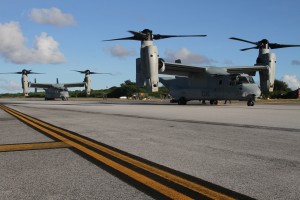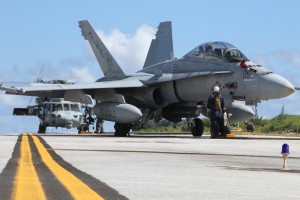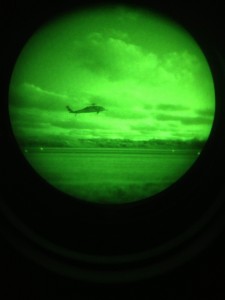2013-01-20 Second Line of Defense had a chance to talk with Major General Christopher Owens, Commanding General, 1st MAW in mid-December towards the end of a major USMC exercise in the Pacific.
http://www.1stmaw.marines.mil/
https://slsp.manpower.usmc.mil/gosa/biographies/rptBiography.asp?PERSON_ID=2072&PERSON_TYPE=General
Second Line of Defense had a chance to talk with Major General Christopher Owens, Commanding General, 1st MAW in mid-December towards the end of a major USMC exercise in the Pacific.
We have had the chance to talk with Owens before during his time in North Carolina.
In this interview, we discussed recent exercises and to Marine Corps approaches to Pacific operations.
SLD: Could you start by providing an update on Forager Fury?
http://www.dvidshub.net/news/99452/exercise-forager-fury-2012-complete#.UOVcjRy0dwc
MG Owens: We are just finishing up Forager Fury. It is a Marine Air Ground Task Force exercise supported by our aviation training relocation exercise program. This program was developed in cooperation with the Government of Japan to provide training opportunities while, essentially, exporting our jet noise. As part of this program, we deploy periodically to Guam and operate there.
We’ve turned it into an air group level exercise where MAG12 brings not only their three of their F-18 squadrons, but also their wing support squadron to do expeditionary airfield operations, and ground combat element forces to provide a broader spectrum of training. The aircraft operate out of Guam, Anderson Air Force base, and Marine Wing Support Squadron (MWSS) operates out of Tinian. MWSS-171 went to Tinian during Geiger Fury held in May of this year. They actually cleared one of the old B29 runways using their expeditionary runway repair capability and made it suitable for KC130s.

And as we go through these fury series exercises, we’ll continue to expand on the North Field at Tinian. We will also do expeditionary airfield ops at West Field, which again is an old B29 base, but now the commercial airport for Tinian. We set up arresting gear and a forward area refueling point there so we could both exercise 171 and also give us some fuel forward that supported our operations in the training areas north of Saipan.
In other words, we did a lot of work with the air group as an air combat element, working hard on shortening the kill chain between detection of targets, assignment of aircraft sorties, the striking of targets, and the assessment of attacks. The group headquarters was augmented with our control group folks and with the wing staff as well to provide the C2 element.
We had aggressor air involved and we had maritime targets in the warning areas south of Guam. We had live troops on the ground, up on the one land-based impact area that we have north of Saipan. The Hornet crews got a good workout, especially during surge periods involving a lot of dynamic retasking of airborne aircraft to new missions. MWSS-171 also got a good workout; they set a record for the number of “traps,” arrested landings, of aircraft when they trapped 13 Hornets in an hour on a single set of expeditionary arresting gear.
What was unique about Forager Fury was this was the first time we deployed MV22s in the exercise.
This was just the first demonstration of the capability that aircraft brings to our AOR. And it went very well; the aircraft self-deployed, nonstop, supported by our KC130 aerial refuelers. They also worked in a fixed wing escort with the Hornets for a training opportunity we don’t often get, complete with aggressor air enroute.
Once we got the Ospreys to Guam, they did troop lifts, they did logistics flights; and then, the culmination was a Tactical Recovery of Aircraft and Personnel mission, to an island 200 miles away from Guam. We simply couldn’t have done this with helicopters without doing front side and backside fueling stops in Tinian or Saipan.
With the Osprey, we were able to do it nonstop flying from Guam.
And the event went off very well.
SLD: Could you talk a bit about the Osprey as a plane working with the F-18s?
MG Owens: One of the challenges of operating the Osprey in a combat environment is how do you protect it from ground and airborne threats enroute, and from ground threats in the objective area?
En route it’s fairly easy to operate in conjunction with our tactical air. It is more challenging in the objective area when you’re talking about very close in fires which have to be very responsive to ground operations.

Typically, that is a role we fill with our attack helicopters, but as this mission demonstrated, we went out to a place where we would not have been able to deploy attack helicopters short of having a ship in the area because the legs were simply too long even from the forward area refueling point.
In other words, we are developing the tactics and the coordination that we need to be able to fill that role with TAC AIR when we need to. We made quite a bit of progress during Forager Fury integrating these two aircraft for complex missions.
SLD: What about refueling of the Ospreys during the flight?
MG Owens: On the deployment to Guam, we did three plugs, three aerial refuelings enroute. We had a divert field at Iwo Jima if it had been required, but It was not needed.
SLD: Some people don’t realize that the USMC deploys with organic air refueling. How important is this capability for the USMC in this type of operation?
MG Owens: It is critical. The obvious challenge of the Pacific AOR is getting there. And self-deployment capability is a must.
The pairing of the MV22s in particular with the KC130s is what really gives us the range to exploit the capabilities of the MV22.
It is a critical pairing, if you will, as much so or more so than for the TAC AIR in the deployment phase. We are going to be stretching our aerial refueling squadron, VMGR 152, and they are getting a good bit of work with the MV22s, but that’s in addition to all the work they’re normally doing with our Hornets as they move around the AOR.
(For more on VMGR 152 see http://en.wikipedia.org/wiki/VMGR-152).

In the next four months, we will deploy Ospreys to Thailand, to the Philippines, to Australia and to the Republic of Korea. All but the South Korean deployment will be supported by KC130s. That aerial refueling capability is what allows us to really stretch our legs.
When you look at it on a map, too, you also recognize the centrality of Okinawa. We have a tendency to look to the southwest for a lot of our crisis response planning because that’s where the typhoons roll through, that’s where the tsunami hit in ’04. Our disaster response humanitarian systems response requirements tend to be the southeast.
But we must also go north if required. Operation Tomodachi, where the earthquake and tsunami hit in northern Japan, we deployed in support of that mission using CH46s, then followed by the MEU and the KC130s.
The 46s took two days and five legs to get up to Naval Air Station Atsugi from which they could support the relief effort in Tomodachi. For the same mission, the Ospreys would’ve been able to do it in a single leg, in about four hours of flight time, same day, and landed it at Atsugi ready to fly missions that day. With a KC130, they could’ve deployed directly from Okinawa to the objective area by aerial refueling.
SLD: There is a broader strategic point, which emerges from your exercise and the range and speed of the Osprey and the multiplier effect, which it and the coming F-35Bs could have on Pacific operations. There are many islands in the Pacific. With the flexibility and relocation skills evident by the USMC (e.g. with regard to expeditionary airfields), islands can be a useful compliment to amphibious to provide the kind of presence which we may well need in the years ahead. What is your thinking along these lines?
MG Owens: This makes sense. We have a relative paucity of amphibious shipping. When I was a young lieutenant and captain, I think we had somewhere in the neighborhood of 65 amphibious war ships in the Navy inventory. Right now, we have 28 and they’re spread about as thin as they possibly can be. We’re running through their lifecycle faster than anticipated, and yet they’re never enough.
Going back to the whole challenge in this AOR is getting to where you need to be with some capability. Being able to stretch the legs of the aircraft and operate from austere sites is critical.
A good case in point is that we just brought a couple of KC130s back from disaster relief in the Philippines, a typhoon rolled through Mindanao and Palawan a few weeks ago. And we deployed a couple of KC130s to haul relief supplies from Luzon to Mindanao.
The KC-130J was the aircraft of choice because there was a useable airfield at the southern end, at the affected end. But had there not been an airfield, which is often the case after tsunamis and typhoons, we could have done the same thing with the Osprey; flown it to Clark Field, operated out of Luzon — loading supplies in Luzon and dropping them to a point landing site in Mindanao supported by KC130s in the air, providing aerial refueling.
And it’s a capability we’ve never had before, and I expect that within the next couple of years, we’ll have an opportunity to demonstrate that the Osprey may be the only aircraft that can get in to an affected area at the distance that we’ll be required to support from.
Whether it be from an intermediate staging base, like Clark or flying directly from MCAS Futenma here in Okinawa.
SLD: So in effect, an airborne infrastructure that allows you to have the reach and range to affect the situation on the ground.
MG Owens: That is a good way to put it. When we put the KC130 into the mix, we can bring some forward basing capability in the form of the maintenance crews that are required not only for the KC130s, but also for MV22s or whatever else that the tanker can drag to the objective area.
We also are experimenting with a kit that could replace our direct air support center (airborne) the system that we used in the legacy KC130s, which does not fit in a KC130J.
We’re looking at a modernized and upgraded version of that kind of command and control capability that we can put in a KC130J. And one of brilliant things about the J is it is so capable; we can do that in an aircraft that is still tanker capable. In other words, it will still have plenty to give in its wing tanks while using the cargo bay, not to hold additional fuel, but to hold the maintenance crews or a command and control capability and so forth. And it’s one aircraft that can do it all.
And as you know, you can configure that aircraft with the low-speed Drogues to refuel helicopters, or the high-speed drogues for the tactical jets and Ospreys. In fact, you can put one of each type in one tanker, so that tanker can have the flexibility to fuel both low-speed or high-speed aircraft.
When you add to that the Osprey and its range and speed, you now have a wider selection of landing spots if we needed an intermediate support base.
A good case in point would be when we wish to deploy helicopters from Futenma to the Philippines, there are a couple of places that we must land for fuel. For one leg, there is only one site, which allows us to do this. But when you have an aircraft with greater range, it opens up more possibilities.
If, in a time of conflict, we were going someplace and an adversary wanted to deny us the ability to put in a refueling point or intermediate support base, they would have to now take into account a much greater number of islands. With only helicopters, an adversary could draw a 100-mile ring around a base and know where we could operate.
Ospreys, particularly when supported by KC-130Js, would significantly complicate an adversary’s attempts to predict our movements and operations.
SLD: A final point. The kind of flexibility that you’re building, first with the Osprey, and then with the F-35B, will make you much your useful to the Combatant commanders in the area. For example, in our discussion with the 7th USAF commander he went out of his way to emphasize the important role, which the USMC provided for the defense of South Korea.
MG Owens: Our relationship with the 7th USAF is excellent. LTG Jouas clearly understands and values what 1st MAW brings to his mission set. And he has been very aggressive about exploiting our capabilities, particularly our unique capabilities in applicable scenarios. When we deploy the F-35B to this theater, it will expand our capabilities and we’re already in work on various scenarios to ensure we can exploit those capabilities whether in support of contingencies or other crisis response requirements.
For an update on Exercise Forager Fury published in the Pacific see the following story:
Guam – Exercise Forager Fury is in full operation on Guam and throughout the Mariana Islands. The Marine Corps exercise includes the use of MV-22 ospreys, which recently replaced the C H-46 helicopters that had been based in Okinawa. Island leaders and the media were invited on a familiarization flight today where the Marines also answered questions about the aircraft.
While V-22s are new to the marines operating out of Okinawa, they have been in use by the Marine Corps for a number of years and have proven themselves in combat.
Looking at both the range of operations whether from operation aboard ship or from land bases we can reach farther faster” said Major General Christopher S. Owens, Commanding General 1st Marine Aircraft Wing. “We can come in with less signature in other words they wont hear us coming they wont see us coming and we can get in and out a lot quicker than we could with helicopters.”
The osprey combines the vertical flight capability of a helicopter with the range altitude and speed of a fixed wing aircraft.
“In helicopter mode all of your lift is being provided by rotors themselves so that’s why they’re in a vertical position just like a helicopter,” General Owens explained. “As the aircraft gets airborne we start moving those wings forward… so as the aircraft accelerates more of the lift is being provided by the wing itself then you also get the control authority on the horizontal tail surfaces too.”
The Ospreys unique capabilities are also valuable for disaster relief. “In the post typhoon, post tsunami type scenarios where you have a lot of devastation these may be the only aircraft that can both reach out that far and bring sizable amounts of gear in and bring it into a confined area. While residents of Okinawa have raised safety concerns about the Osprey, General Owens says that the Marine Corps has determined that that the fatal accident in Morocco last April resulted from procedural errors that had been made by the aircrew. When asked about an informational request issued by the navy regarding a wiring fault General Owens noted that the aircraft requires significant maintenance but said he is confident in its safety. “ Of the 50 or 60 aircraft that I remember being compared it is in the Top 5 as far as safety record goes” General Owens stated.
For Geiger Fury see the following:
For a look at our recent Special Report on USMC con-ops innovations associated with the new aviation assets see the following:
https://sldinfo.com/the-ace-of-the-future-yuma-and-beyond-2/
For an additional look at the Osprey roll-out in the Pacific see the perspective of the Commanding Officer of the 31st MEU:
https://sldinfo.com/the-osprey-comes-to-the-pacific-the-case-of-the-31st-meu/

